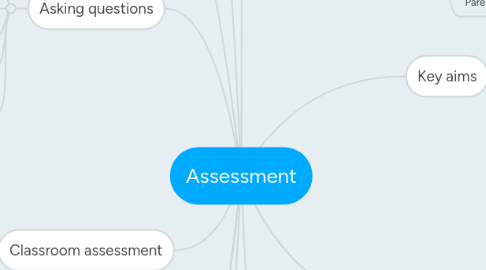
1. Assessment components
1.1. Assessing
1.1.1. How we discover what the students know and have learnt
1.2. Recording
1.2.1. How we choose to collect and analyse data
1.3. Reporting
1.3.1. How we choose to communicate information
2. Discovering what students have learnt
2.1. Assessing students prior knowledge and experience as well as monitoring their achievement during the teaching period will allow us as teachers to plan and refine our lessons accordingly.
3. Summative assessment
3.1. Allows students and teachers an insight into the students prior knowledge and understanding
3.2. Gives the students the oportunity to demonstrate what they have learnt.
3.3. Informs and improves students learning and measures understanding of the central idea whilst prompting them to take action
4. Classroom assessment
4.1. Using representative examples of students work or performances to provide information about student learning
4.2. Collecting evidence of students understanding and thinking
4.3. Documenting learning processess of groups and individuals
4.4. Engaging students in reflecting on their learning
4.5. Students assessing work produced by themselves and by others
4.6. Developing clear rubrics
4.7. Identifying exemplar student work
4.8. Keeping records of tests\task results
5. Asking questions
5.1. Have the task provıded ample information to provide judgement to be made
5.2. What does the students perfromance reveal about their level of understanding
5.3. Have any unexpected results occured?
5.4. What changes could be made?
5.5. How should the teaching and learning process be modified?
6. Assessment straegies
6.1. Observations
6.2. Performance
6.3. Assessments
6.4. Process-focused assessments
6.5. Selected responses
6.6. Open-ended tasks
7. Assessment tools
7.1. Rubrics
7.2. Exemplars
7.3. Checklists
7.4. Anecdotal records
7.5. Continuums
8. Key aims
8.1. To provide feedback on the learning process
8.2. To gather and analyse information
8.3. To identify what students know, understand, can do and feel.
8.4. To not only reflect upon the work of the students but also of yourself as a teacher.
8.5. Assess both the process of inquiry as well as the products of inquiry.
9. To observe
9.1. Has the nature of students inquiry developed over time? Are they asking more in-depth questions?
9.2. Have students become aware that problems require solutions based on a vast array of knowledge?
9.3. Are students demonstarting that they have mastered the skills that are being taught?
9.4. Are students accumilating a vast knowledge base and showing that they can apply this knowledge to other scenarıos?
9.5. Are students demonstrating that they can work both individually and collaboratively?
10. Effective assessments
10.1. Students
10.1.1. Share their learning and understanding with others
10.1.2. Demonstrate a range of knowledge, cenceptual understanding and skills
10.1.3. Use a variety of learning styles multiple intelligences and abilities to express their understanding
10.1.4. Know and understand in advance the critera for producing a quality product or performance
10.1.5. Participate in reflection, self and peer assessment
10.1.6. Base their learning on real life experiences that can lead to further inquiries
10.1.7. Express different points of view and interpretations
10.1.8. Analyse their learning and understand what needs to be improved
10.2. Teachers
10.2.1. Inform every stage of the teaching and learning process
10.2.2. Plan in response to student and teacher inquiries
10.2.3. Develoıp criteria for producing a quality product or performance
10.2.4. Gather evidence from which sound conclusions can be drawn
10.2.5. Provide evidence that can be effectively reported and understood by the whole community
10.2.6. Collaboratively review and reflect on student performance and progress
10.2.7. Take into account a variety of learning styles, multiple intelligences and abilities including different cultural contexts
10.2.8. Use scoring this is both analytical and holistic
10.3. Parents
10.3.1. See evidence of student learning and development
10.3.2. Develop an understanding of the students progress
10.3.3. Provide opportunities to support and celebrate student learning
11. Adding variety
11.1. Students should be observed in a variety of situations and a wide range of assessment strategies should be implemented.
11.1.1. By doing this teachers can build up a clear picture of the students and his or her interests
11.1.2. Teachers can identify what and how the students are thinking and learning
11.1.3. Teachers can assess the effectiveness of the environment on the students learning
11.1.4. Extend the students learning
